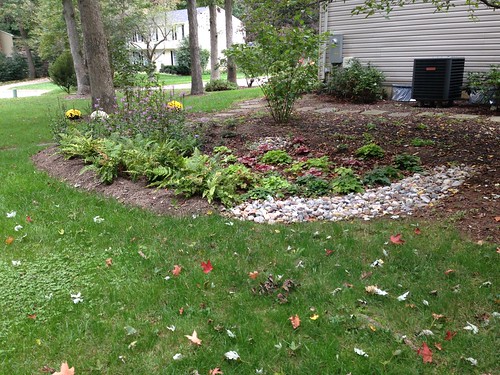
Flood damage at Patapsco State Park by Joe Vogelpohl, Maryland Park Service
Spring rains bring a great deal of water to properties. Everyone has seen and struggled with puddles and flooding on roads and walkways, causing detours and splashes. However, most people don’t give much thought to water once it has left their property or what happens to our streams and rivers during rain events. The increase in impervious surfaces and piping to alleviate flooding from human pathways and direct it quickly to streams can have a detrimental effect on our waterways.

Harford Soil Conservation District bank erosion before stream restoration
Erosion caused by stormwater has become more widespread as development increases. What were once consistent flows have become flashier, with efficient sewers to immediately dump water into streams from roads and yards. This can be from concrete paving, ditching of small ephemeral streams, or piping from rooftops into drains that dump straight to streams. More water makes it into streams quickly, ponds are quickly emptied, and once the rain has passed, streams have less input, so they are either flooded or very low. This contributes to the erosion of banks, the scouring of the bottom, and blowouts of submerged vegetation and woody wetlands.
Our streams and rivers provide important habitats for a wide variety of animals, from fish and birds to small insects. The eggs and young animals can be injuredor killed from storm events, and habitat degraded to empty muddy channels. Texture and diversity of plants, rocks, and flow regimes promotes biodiversity, while erosion tends to eliminate it. Fewer beneficial insects, fish, amphibians, and plants can survive in eroded streams, and water quality tends to decrease. All these streams contribute to the health of larger downstream bodies of water like the Chesapeake Bay, and some are sources of drinking water, which we should be trying to keep as clean as possible.
To slow down erosion and improve water quality, there are a great many things we can do, and many programs are available to help. Rain gardens, rain barrels, swales, green roofs, native ground cover, pavement removal, or permeable pavers are all improvements private landowners can make to their own property.

A homeowner rain garden that collects roof runoff
Any method to encourage water to slow down and spend more time moving through your property gives it more time to filter through soil, soak into plants, and settle pollutants. Rain gardens are helpful for this because they are planted in depressions in the soil where water can accumulate, hold for longer periods of time, soak into the soil, and be taken up by water-loving plants. A downhill portion of your property that often puddles or a washed-out ditch near your gutter output is a great location for installing a rain garden. Swales are ridges on sloped land that slow the flow of water downhill, slowing down erosion. Rain barrels reduce the amount of water that flows off your roof in any given rain event and retain it for later use, most often in gardens or lawn watering. Green roofs are planted with shallow-rooted plants that can uptake rain before it runs off the roof, and they can act as an additional insulating layer during the summer heat, offering evaporation from the plants to help cool buildings. Native ground covers can be more tolerant of intermittent rains and have deeper roots than sod for better groundwater penetration and uptake. Replacing pavement with permeable pavers or removing it entirely allows for more surface area for water to penetrate and slows down the flow to streams.

A rain garden in action during a rain event
Many counties, townships, and states have programs to assist with paying for these improvements, for residential, commercial, and even HOA properties, usually in the form of a rebate or tax credit. Even if you don’t have property, you can bring it up at an HOA meeting, advocate for it at work, or suggest public improvements at local government meetings. Next time there is a big rain event, identify some problem areas in your neighborhood and bring them up to the folks responsible for that land.
Improving stream quality will help all our aquatic wildlife, providing recreation, hunting, and fishing opportunities for years to come.
For more information:
Maryland Department of the Environment – Facts About Rain Gardens, Rainwater Harvesting, and Dry Wells
Alliance for the Chesapeake Bay – Native Plants for Rain Gardens
Maryland Department of Agriculture – Erosion Tips
Spring is here, HabiChatters!
In this issue, you’ll find a native plant and native animal profile about some of the first (and best) harbingers of spring. Education Assistant Edwin Guevara offers some ways to get your teens into nature with technology; if you can’t get them off their screens, bring the screens outside! And last but not least, guest author Samantha Lott, one of our fantastic Natural Resources Technicians, offers us great insight and advice about dealing with the consequences of heavy spring rains. We hope you get outside as the weather warms up in your Wild Acres!
Sarah Witcher
Sarah.Witcher1@Maryland.gov
410-260-8566
Click here to have HabiChat—the quarterly backyard wildlife habitat newsletter from the Wild Acres program—delivered right to your inbox!
In this Issue

